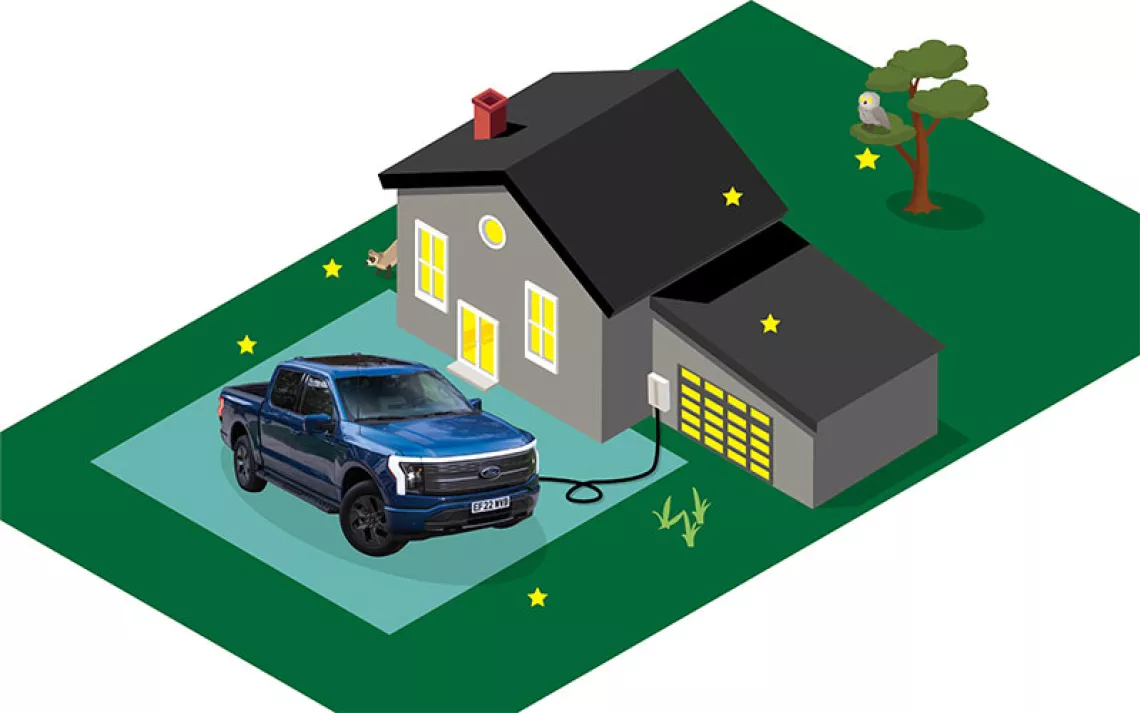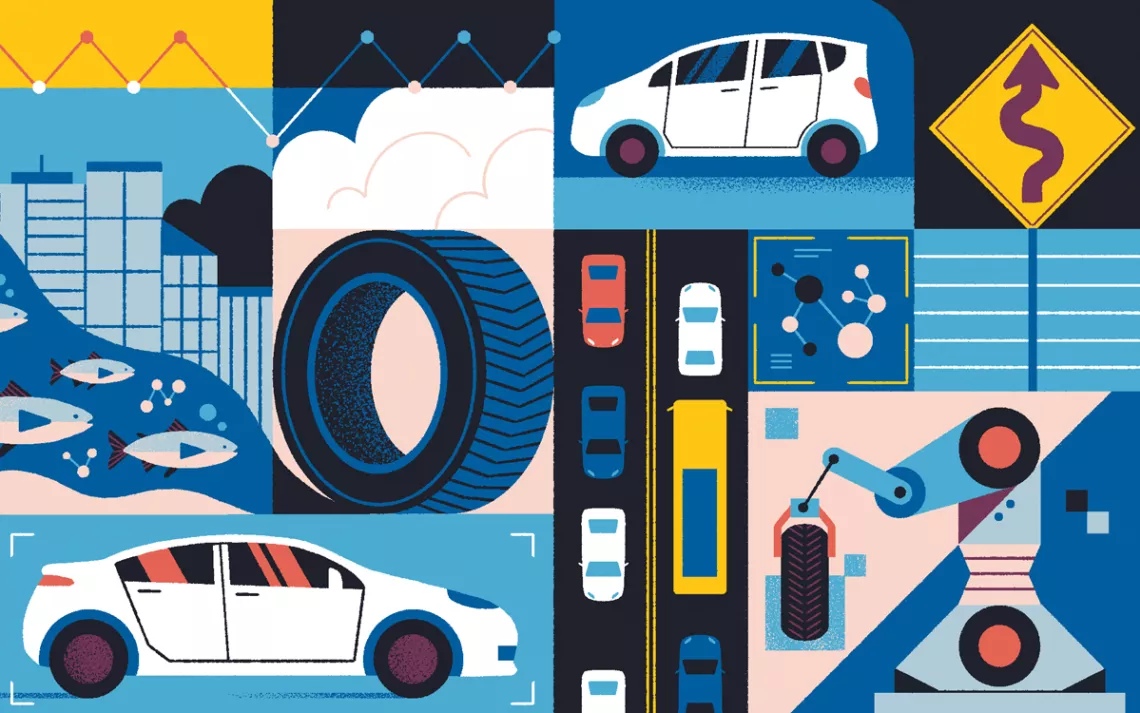Electric Cars Need a Boost. Electric Utilities Can Provide It.
Charging systems for EVs need to be as common as gas stations

Animation by Nicholas Little
IT TOOK MANY YEARS, BUT AUTOMAKERS have finally succeeded in making electric cars that are generally affordable, powerful, and even cool. What they haven't made, however, is a meaningful dent in the U.S. vehicle market, in which EVs represent less than 1 percent of cars sold.
That may soon change with the entry of a new player, one with bold plans for zero-emission transportation: electric utilities.
Yes, that's the same Big Electric that labored for years to block solar panels from our rooftops. But utilities see big profit in electrifying our wheels, and they're moving to boost the EV's appeal (and ease potential buyers' battery-range anxiety) by making sure that charging stations are as common as gas stations.
"If any group has the motive and the means to get electrification off the ground, the utilities are the folks to do it," says Sierra Club associate attorney Joe Halso, who works on cases that include EV expansion plans. "The possibilities for decarbonizing transportation, as well as the potential benefits for the grid and for renewables, are enormous."
California—claiming half of all U.S. electric car sales in 2016—is leading the way, with generous rebates for clean vehicles and an aggressive mandate to get 1.5 million zero-emission vehicles on the road by 2025. The state's three big investor-owned utilities—Southern California Edison, Pacific Gas & Electric, and San Diego Gas & Electric—have collectively proposed spending $1 billion on EV infrastructure in the state in order to install 10,000 new charging stations.
Those plans call for charging systems everywhere from airports to shopping centers to workplaces to ride-share pickup zones. The bulk of the proposals—half a billion dollars' worth from Edison alone—are for laying conduit and power lines for charging stations at warehouses, public transit hubs, and distribution centers. This could accelerate the adoption of electric buses and trucks—not by the vehicle, but by the fleet.
Other elements of the utilities' plans could be a model for electrifying transportation in the rest of the country. Edison, for example, is proposing rebates for ride-share drivers who use EVs and for homeowners who hire electricians to install car chargers, and it's deploying clusters of fast-chargers at apartment complexes, airports, and shopping malls. Charging infrastructure is also being considered for electric buses and for cranes and vehicles at the busy Port of Long Beach.
"Transportation electrification has huge greenhouse gas and air-quality benefits," says Laura Renger, principal manager of air quality and climate at Edison. "It provides a flexible resource for the grid, and it leads to lower rates for everyone."
Similar, if less ambitious, utility investments are moving forward in Oregon, Utah, Washington, and Massachusetts. To fulfill state climate change mandates, National Grid and Eversource in Massachusetts are proposing to invest more than $68 million in nearly 5,500 charging ports in hundreds of locations—just the pilot phase for an expansion that may accommodate hundreds of thousands of EVs by 2025. Utilities in other states offer preferential electric rates for EV owners or rebates to customers who install charging stations.
Not everyone is happy with the rise of the EV. Fossil fuel interests and climate-skeptic politicians are waging a state-by-state war on incentives and tax breaks for electric-car buyers. Georgia, for example, repealed its $5,000 tax break for electric vehicles and replaced it with a $200 fee, crushing EV sales. At least 15 other states have passed, or are now considering, EV fees.
Some advocacy groups, like San Diego's Utility Consumers' Action Network, are dubious about the utility investments. They oppose utility ownership of charging stations in private homes and are concerned about the fairness of having all ratepayers subsidize the few who have electric cars. Legislators have long been concerned that utility investments in transportation would stifle competition in the electric-vehicle space, which is why California and other states have banned such investments in the past.
But there has never been much competition in the vehicle-charging business. The result has been a lack of infrastructure and a minuscule market for EVs. In 2016, a record year for EVs, the 25th-most-popular car in America (the Chevy Cruze, ever heard of it?) outsold all car models with a plug combined.
After 2015, California legislators realized that EVs would never take off without places to plug in and instructed the state's utility commission to encourage investment in charging infrastructure. Washington, Oregon, Utah, and other states have also flipped the switch on utility investments.
It's true, Renger concedes, that investing in building EV charging lines and stations will add to customers' electric bills—but not by very much. The $570 million that Edison is proposing to invest across five years will cost the average ratepayer an extra 53 cents a month, or 29 cents for low-income households.
In exchange, she says, ratepayers can look forward to lower rates in the future, as "smart-charging" during off-peak hours makes the grid more efficient. EV owners could charge their batteries with abundant renewable energy in the morning when they parked their cars at work, easing strain on the grid during peak demand in the afternoon. Eventually, vehicles could be used as storage devices for the day's renewable energy, putting power back into the grid in the afternoon and evening. Later in the day, as demand slowed, smart-chargers could switch on and ready EVs for the morning commute. Such a network could power large numbers of EVs without requiring a lot of new generating capacity.
"That's the vision: decarbonizing the transportation sector, maximizing the use of renewables, and widespread grid benefits," Halso says. Transportation, according to the U.S. Energy Information Administration, has now surpassed power generation as the single-largest source of greenhouse gas emissions in the United States. Linking the two through the large-scale adoption of electric vehicles could reduce emissions from both.
This article appeared in the September/October 2017 edition with the headline "Jump Start."
WHAT YOU CAN DO
Thinking about ditching your fossil fuel burner? Join National Drive Electric Week, September 9 to 17, for test drives and opportunities to talk to EV owners and learn about the cars' benefits. Sign up at driveelectricweek.org to find an event near you.
 The Magazine of The Sierra Club
The Magazine of The Sierra Club



